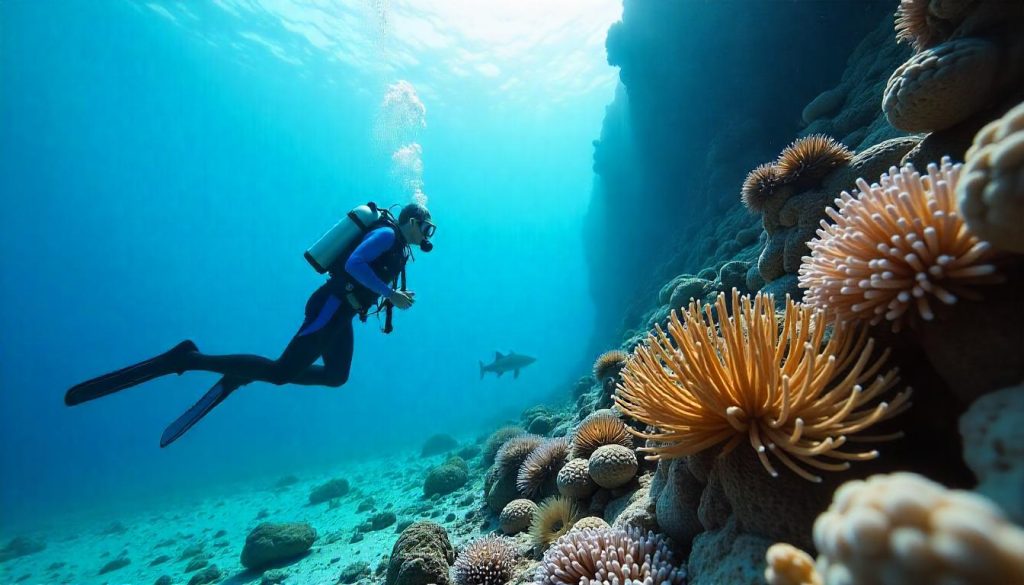红海是埃及东海岸的海洋天堂,拥有世界上最原始的水下生态系统,因此 2025 年的红海潜水点是潜水爱好者的必游之地。根据海洋数据,这里的珊瑚礁绵延 2000 多公里,平均水温 26°C,海洋生物生机勃勃,能见度高达 40 米。从赫尔格达熙熙攘攘的潜水中心到兄弟群岛遥远的珊瑚礁,本指南将探索埃及人迹罕至的潜水点,突出它们的独特之处,并提供安全潜水探险的实用技巧。让我们一起潜入红海的海底奇观。
赫尔格达通往红海潜水点的门户
赫尔格达是一座繁华的海滨城市,是通往红海潜水点的门户,方便游客前往世界一流的潜水点和现代设施。从赫尔格达码头出发,每天都有潜水船前往附近的珊瑚礁。例如,全天潜水之旅的费用为 $80,包括设备和每位操作员的费用。此外,根据港口数据,码头水深 5-7 米,适合大型船只。您可以在当地商店购买防晒霜,每个商贩的价格为 $10。据报道,这里的海水平均温度为 26°C,非常适合潜水。因此,赫尔格达是红海潜水之旅的理想基地。
吉夫顿群岛珊瑚天堂
从赫尔格达乘船前往吉夫顿群岛(Giftun Islands)很近,那里是潜水爱好者的珊瑚天堂。例如,根据报道,群岛水域的平均温度为 26°C,能见度可达 30 米。此外,根据潜水导游的介绍,您还可以在小吉夫顿漂流等景点潜水,那里以软珊瑚和海鳗而闻名。该地区是海洋公园,根据公园规定,每位潜水员的入场费为 $5。当地人说,您可以在海葵中看到小丑鱼,这是常见的景象。此外,根据经营者的说法,漂流潜水的水流平缓,适合各种水平的潜水者。这个充满活力的地点让吉普顿群岛成为一大亮点。因此,它是赫尔格达潜水者的必游之地。
埃尔范纳迪尔礁宏观天堂
位于赫尔格达北部的埃尔法纳迪尔珊瑚礁为潜水者提供了一个宏观天堂。例如,根据潜水图,该珊瑚礁的平均温度为 26°C,水深 10 米至 30 米不等。此外,根据海洋指南,您还可以在珊瑚中发现裸鳃和海马。当地人说,该潜水点的沙质海底是观赏鳐鱼的理想地点。建议您带上水下相机,因为这里的微距生物非常迷人。此外,这里风平浪静,非常适合初学者。埃尔法纳迪尔礁水下世界的细节让人眼前一亮。因此,它是赫尔格达微距爱好者的首选之地。
达哈布悠闲的潜水胜地
达哈布是西奈半岛上的一个小镇,为寻求红海宁静体验的潜水者提供了一个悠闲的度假胜地。达哈布的潜水中心,如蓝洞潜水中心(Blue Hole Divers),每天提供 $60 的行程,包括设备,每位操作员的价格为 $60。据报道,达哈布的海水平均温度为 25°C。此外,您还可以逛逛当地市场,贝都因手工艺品的价格为 $15,按商贩计算。根据预测,该地区的水流平均为 1 节,可确保轻松潜水。根据旅游指南,从沙姆沙伊赫驱车 2 小时即可到达。因此,达哈布是休闲潜水的理想之选。
蓝洞:深潜挑战
蓝洞是达哈布最著名的景点,为经验丰富的潜水员提供了深潜挑战。例如,根据潜水图,该潜水点的深度达 100 米,在 55 米处有一个拱门与公海相连。此外,根据报告,这里的海水平均温度为 25°C,能见度可达 40 米。根据海洋导游的介绍,您可以在拱门附近发现鲹鱼和梭鱼。由于水深,该潜水点需要高级认证,经营者称。此外,根据当地人的说法,周围的礁壁覆盖着硬珊瑚。这一标志性景点使蓝洞成为一大亮点。因此,它是经验丰富的潜水员在达哈布的必游之地。
峡谷潜水点:地质奇观
达哈布附近的峡谷潜水点为潜水者提供了一个地质奇观。例如,根据潜水图,峡谷的岩壁落差达 30 米,形成了一个狭窄的游泳通道。此外,根据报道,这里的海水平均温度为 25°C,能见度高达 35 米。根据海洋导游的介绍,您可以在峡谷内看到闪闪发光的玻璃鱼。该潜水点离海岸很近,操作员称可以进行岸潜。此外,当地人表示,平静的环境适合中级潜水员。这种独特的形成使峡谷脱颖而出。因此,它是潜水员在达哈布的第一站。

兄弟群岛遥远的红海探险
兄弟群岛(Brothers Islands)是红海中的一对偏远小岛,为寻找人迹罕至的珊瑚礁的潜水者提供了一个冒险的去处。从赫尔格达(Hurghada)出发,乘坐船宿即可到达,5 天的行程费用为 $1,200 美元,包括膳食,每位操作员的费用为 $1,200 美元。据报道,这些岛屿的海水平均温度为 27°C。此外,该地区以水流湍急而闻名,平均水流速度为 2 海里/小时,潜水向导称这需要高级技能。根据海洋数据,您可以看到海洋白鳍鲨,这是一次惊险刺激的邂逅。根据经营者提供的信息,偏远的地理位置确保了原始的珊瑚礁。因此,兄弟群岛是经验丰富的潜水员的理想选择。
老大哥沉船潜水体验
大哥岛是两个岛屿中较大的一个,它为潜水者提供了沉船潜水体验。例如,Numidia 沉船是一艘 1901 年的英国货船,潜水图显示其深度为 10 米至 80 米。此外,根据报告,这里的海水平均温度为 27°C,能见度可达 40 米。您可以探索沉船上布满珊瑚的船体,根据海洋向导的介绍,您还可以在附近看到双髻鲨。该地点的水流可能很急,操作员需要仔细规划。此外,根据历史记录,沉船的历史也增添了几分神秘色彩。这种冒险的潜水让 "老大哥 "号成为一个亮点。因此,它是兄弟群岛的必游之地。
小兄弟鲨鱼热点
较小的小岛 "小兄弟 "为潜水者提供了一个鲨鱼热点。例如,根据潜水图,该地点的落差达 100 米,吸引了长尾鲨。此外,根据报道,这里的海水平均温度为 27°C,能见度高达 40 米。根据海洋指南,您可以沿着礁壁潜水,观赏生机勃勃的软珊瑚。该潜水点与世隔绝,潜水员流量极少。此外,根据当地人的说法,强劲的水流使其成为一个漂流潜水点。这个惊险刺激的地点让 "小兄弟 "一枝独秀。因此,它是兄弟群岛鲨鱼爱好者的首选之地。
马尔萨阿兰:红海南部的一颗宝石
马尔萨阿兰(Marsa Alam)是红海南部的一个小镇,为寻找人迹罕至地点的潜水者提供了一个更安静的选择。像马尔萨阿兰潜水中心(Marsa Alam Divers)这样的潜水中心每天提供 $70 的行程,包括设备和操作员。例如,据报道,该镇水域的平均温度为 28°C。此外,您还可以逛逛当地市场,那里的珊瑚饰品售价为 $20,按商贩计算。据预测,该地区的水流平均为 1 节,可确保潜水时风平浪静。根据旅游指南,从赫尔格达出发需要 4 个小时的车程,沿途风景优美。因此,玛尔萨阿兰非常适合隐居潜水体验。
埃尔芬斯通礁中上层鱼类天堂
马尔萨阿兰附近的埃尔芬斯通礁为潜水者提供了一个浮游生物天堂。例如,根据潜水图,礁石的高原下降到 70 米,吸引了长颌鲨。此外,根据报道,这里的海水平均温度为 28°C,能见度可达 40 米。根据海洋指南,您可以沿着珊瑚礁的北壁潜水,观赏珊瑚扇。该潜水点的水流可达 2 海里/小时,需要操作者具备高级技能。此外,根据当地人的说法,珊瑚礁鲜艳的色彩使其成为摄影师的梦想之地。这个充满活力的地点让埃尔芬斯通礁成为一个亮点。因此,这里是马萨阿兰的必游之地。
海豚之家浮潜天堂
海豚之家(Dolphin House)又名沙阿布-萨马代(Sha'ab Samadai),是潜水和浮潜爱好者的浮潜天堂。例如,根据潜水图,泻湖的平均温度为 28°C,水深 5 至 15 米。此外,根据海洋导游的介绍,您还可以与飞旋海豚一起游泳,这是常见的景象。该潜水点属于海洋公园,根据公园规定,每人需支付 $10 的门票费。您应该预订有导游的旅行,因为经营者会对游客的进入进行管理。此外,根据当地人的说法,平静的泻湖非常适合家庭游。这个神奇的地方让海豚馆脱颖而出。因此,它是马萨阿兰的首选之地。
红海潜水实用技巧
要在 2025 年成功完成红海潜水之旅,需要精心策划,以确保安全和愉快的体验。例如,根据埃及气候数据,最佳潜水时间是 3 月至 5 月和 9 月至 11 月,这两个季节的平均气温为 25°C。此外,要提前预订潜水船,尤其是前往兄弟群岛的潜水船,因为根据经营者的说法,旺季时潜水船会爆满。您应该携带一件 3 毫米的潜水衣,因为根据数据,冬季海水温度会降到 22°C。此外,还应准备一台潜水电脑,因为许多景点都有很强的水流。因此,做好准备工作可确保潜水探险顺利进行。
红海最佳潜水时间
合理安排潜水之旅的时间可增强您的红海体验。根据预测,3 月至 5 月和 9 月至 11 月潜水条件最好,能见度最高。例如,根据数据显示,四月的海面较为平静,非常适合前往埃尔芬斯通礁。不过,根据报道,6 月至 8 月的气温较高,平均温度为 30°C。此外,根据导游的介绍,肩月的人流较少,因此海豚屋等景点较为安静。运营商表示,温和的天气确保了潜水的舒适性。因此,春季和秋季是在红海潜水的最佳时节。
在红海安全潜水
在红海安全潜水可确保旅行无忧。例如,兄弟群岛水流湍急,需要潜水向导,经营者建议每天花费 $50。此外,您还应检查自己的装备,因为蓝洞等景点的深度可能很有挑战性。关注天气更新,因为根据埃及法律,违规罚款可达 $100。此外,根据规定,应避免触碰珊瑚,以保护海洋生态系统。这些准备工作可确保您顺利下潜。因此,安全措施和当地专业知识至关重要。
总结:2025 年的红海潜水点
2025 年的红海潜水点为您提供了一次领略埃及水下宝藏的非凡之旅。赫尔格达(Hurghada)和达哈布(Dahab)是充满活力的起点,有吉普顿群岛(Giftun Islands)和蓝洞(Blue Hole)等景点。兄弟群岛和玛尔萨阿兰(Marsa Alam)则是沉船和鲨鱼的遥远探险地,展现了红海的多样性。此外,周密的计划可确保在这些纯净水域的潜水安全。在 2025 年潜入红海,探索为什么红海仍然是潜水者的首选目的地,将人迹罕至的珊瑚礁和生机勃勃的海洋生物融合在一次难忘的旅行中。

 航行红海:埃及未开发的潜水点">
航行红海:埃及未开发的潜水点">
